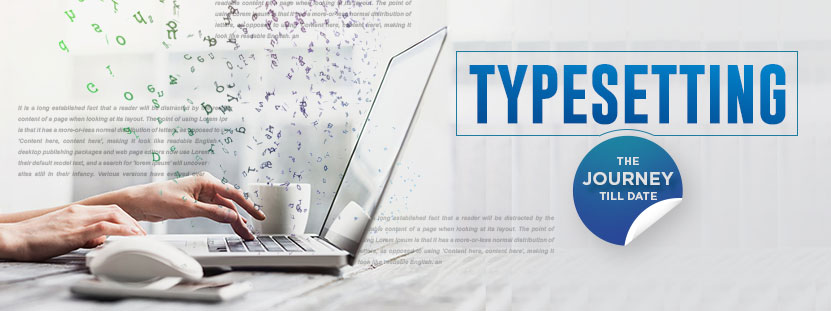History of Typesetting: The Journey of Till Date
Modern-day sophisticated digital word processing programs facilitate accurate fonts/line spacing and classier page layouts. However, we must also remember the times in the past when type was set by hand and produced flawless outcomes.
The new-age modern typesetting systems promote easy line leading, kerning, and tracking. However, the first crude form of typesetting started in the 19th century. It was from then on that new methods emerged. With each technological advancement, speedier typesetting processes appeared.
A lot of time has passed since the first typesetting device. Let’s take a tour through the history of typesetting in this article. This will allow us to get an idea about the typesetting guide and the history of typography:
What is typesetting?
Typesetting is the digital process of arranging text and images on a manuscript to prepare content for printing or digital publication. The process involves adjusting fonts, spacing, copyediting, proofreading, alignment, margins, and layout to ensure readability and a professional appearance.
The process can be dated back to the letterpress era when typesetters adjusted movable types manually. Be it a full-fledged book, a book cover, or a magazine, the correct type matters the most to create a great reading experience.

Types of typesetting
Manual typesetting
Movable type was commonly composed by hand for each page during the letterpress era. Cast metal sorts were formed into words, lines, paragraphs, and text pages and bound together. This created a form kept in a press and then inked to make a mark on the paper.
During the process, the right hand is used to pick individual sorts from a type case, and they are then fixed into a composing that is held in the left hand. For centuries, wooden sorts were paired up with metal sorts. One major aspect of the caster man is the “set” or width of every sort. The width of the set is measured in points.
This typesetting design was commonly used to print books and newspapers with rotary presses. In a process called stereotyping, the form is pressed into a fine matrix, named “Flong”. This is done to form a positive from which stereotypes can be electrotyped.
Back then, there was a predominant use of letterpresses, also called platen presses, to create business cards. After this, the California Job Case was introduced, allowing a quick way to hand-set the type. It was in China that movable type blocks were invented and made from wood, and it was Johannes Gutenberg who developed the first printing press. Till then, type was set by hand and implemented through letterpresses.
In this process, you should begin by selecting a font and size in a particular drawer. Each letter should be selected individually and put into the composing stick. Next, you need to add m or n-spaces as well as line leadings to justify the copy or facilitate left or right alignments. Once a section is completed, you have to place it in a frame called “Chase”.
After this, you have to use blocks of wood to secure it using a quoin lock. In the next step, the chase needs to be placed into the letterpress to facilitate the printing process. Notably, people using this process in the past used to keep lower case letters in the “lower” case and upper case letters in the “upper” case.
Interestingly, the hand-set type generated copies of the Constitution and the Declaration of Independence. Unfortunately, during the mid-18th century, typos were quite common in copies.
Hot Metal Typesetting
The introduction of hot metal typesetting during the 19th century marked a great innovation in the industry. The invention took typesetting to a great height. The hot metal typesetting process involved using a keyboard similar to a typewriter by an operator referred to as the typesetter.
It was during the 1880s that the Linotype machine was used in the same manner to create ‘casting matrices’, which could cast a whole line of type. This method was much more efficient than the previous methods. As it could generate an entire line as a single piece of lead instead of generating one letter or space at a time.
However, the operators were still required to place the line into a chase and keep it fixed with quoins. But the positive point was that the tedious job of hand-setting each letter could now be replaced with a sort of automated process of setting.
-
Phototypesetting
It was during the 1960s that phototypesetting emerged as the most commonly used method for setting type. During this time that the hot metal and Linotype machines lost their credibility in the market. In this process, thick plastic discs or glass were used as the carriers of the fonts and word stacks that needed to be used.
These discs were spun speedily before a light source and a photo-sensitive paper were exposed to this light. This allows it to be processed and pasted on artboards. The typesetter needed to open the machine to remove the disc or strip to switch fonts or to replace one type of font with a new font.
Typesetting was regarded as a demanded skill at that time. Since the typesetter had to determine kerning, leading, spacing, tracking, font size, and returns precisely. Only after this, the space would become a perfect fit to be used by the graphic artist. The typesetters had to measure the word spacing to include visuals and configure the type.
This process was far more efficient than hot metal typesetting or hand-set type. Yet, it still called for the operators’ skill or knowledge to ensure that the type fitted the selected space. Moreover, it was appropriately formatted around images or illustrations.
The Advent of the Digital Typography
The phototypesetting machines underwent evolution, and another generation of typesetting devices was launched. These machines produced characters on a cathode ray tube. Among the most popular machines used were:
- Alphanumeric APS2 (1963)
- IBM 2680 (1967)
- Videocomp (1973)
- Autologic APS5 (1975)
- Linotron 202 (1978)
These devices were predominantly used during the 1970s and 1980s. Interestingly, a computer front-end system was used to drive these machines online. And type fonts were stored on traditional magnetic disk drives in digital format.
During the 1980s, completely digital systems with raster image processors that efficiently supported image settings were introduced. The introduction of these digital systems pushed out computer-aided phototypesetting from the market.
Monotype LaserComp was the first laser imagesetter that was successfully used on a commercial scale. This device came equipped with a raster image processor. This was soon followed by the introduction of similar machines by companies such as Compugraphic and ECRM.
The 1970s witnessed the introduction of earlier models of minicomputer-based typesetting software. Some of the most noted programs were Penta, Xyvision, Datalogics Pager, Troff, IBM’s Script, Atex, and Miles 33. These programs were compatible with the electromechanical devices.
Besides, they made use of text markup languages to communicate type and formatting-related data. With time, these text markup languages assumed their present-day forms, namely, SGML, XML, and HTML.
These minicomputer systems used imposition software on devices and produced entire pages and signatures of 4, 8, 16, or more pages. A typical example is that of Scitex Dolev, made in Israel. These systems used data stream to enable page layout on imagesetters and printers.
Such systems were unique to a specific manufacturer or machine for exclusive features. These further promoted the development of Hewlett-Packard's PCL, Adobe Systems' PostScript. As well as some other generalized printer control languages. Interestingly, a certain section of Oscar Wilde’s essay “The Renaissance of English Art” was typeset in italics. The font used was Iowan Old Style, adjusted to 10 words per line.
Computerized typesetting and formatting were not much in practice as of then. Notably, the BYTE magazine never used computers in production till 1979. BYTE used a Compugraphics system to generate copies of its August 1979 issue.
The magazine used a computer graphics system for typesetting and for designing page layouts. Yet it discouraged floppy disks for article submission though it indicated to use floppies at a later period. Specialist typesetting companies used to handle the typesetting needs of publishers and advertisers before the 1980s. They accounted for a large percentage of the graphics art industry.
These companies also provided end-to-end typesetting support. This included keyboarding, proofreading and editing, and producing film or paper output. These companies were located in the rural areas of the United States, namely in New England or rural Pennsylvania.
Desktop publishing was introduced in 1985. The world witnessed the launch of Apple Macintosh, Aldus Pagemaker, PostScript, and QuarkXpress. Software and hardware enhancements and reductions in typesetting costs made desktop publishing very popular. Additionally, desktop publishing allowed typesetters to exercise fine control over the typesetting outcomes.
Desktop publishing was not just about setting type. The advent of PageMaker and Quark now transformed a typesetter into a graphic artist. Typesetters could now select fonts and manipulate the size and could perform the following:
- Spacing
- Kerning
- Tracking, or,
- Leading
- efficiently wrapping graphics around the screen. The typesetters could scan images, put them on the page and create vignettes or blends. All these functions were previously done by professional designers.
Ultimately, Adobe created a software suite that we refer to as Creative Suites today. This suite supported integration across major programs. So far, the graphic artists had only artboards and rubylith to work with. But now they could design intricate designs previously impossible, even with typesetting machines.
The cost was remarkably less than the costs associated with using minicomputer-run systems. During the same time, Wang, WordPerfect and other word processors gave a whole new makeover to office documents. However, these word processing systems still lacked the typographic capability or flexibility that is needed to produce books of complicated layouts that might feature graphics or mathematics. These processors could not support advanced hyphenation and justification rules as well.
It is noteworthy to mention that by 2000, this segment lost its importance because publishers had now started incorporating typesetting and graphic design into their in-house systems. Some book designers chose to allocate this task to freelancers. The availability of free fonts made the do-it-yourself approach popular, but a large gap was observed between amateurs and skilled designers.
The arrival of PostScript, along with the PDF format, promoted a worldwide method for proofing layouts and designs, and the documents were accessible on multiple operating systems and computers.
SCRIPT Variants
IIBM created as well as prompted the development of typesetting languages with names derived from “SCRIPT”. The advanced versions of SCRIPT consisted of new features such as multicolumn page layout, automatic generation of index and table of contents, automatic hyphenation, footnotes, spelling verification, and automatic hyphenation.
Later, scholars at the University of Waterloo created the Waterloo Script. MIT created a version of SCRIPT, and the UW used the program for the first time in 1975. During the 1970s, the SCRIPT was the only feasible option to format documents and perform word processing using a computer. During the latter half of the 1980s, the SCRIPT was enhanced with several upgrades.
In the May 1975 issue of the Computing Centre Newsletter, the following positive points about SCRIPT were mentioned:
- It could easily format footnotes.
- The page numbers could appear in Roman or Arabic numerals, at the center, left, or right of the page, or on the top and bottom of the page.
- Overstriking or underscoring could be made to work as a SCRIPT function.
- The SCRIPT files were found to be CMS files or OS databases.
- Users could access outputs either at the terminal or on the printer.
SGML and XML Systems
IBM’s Generalized Markup Language (GML) forms the basis of the standard generalized markup language (SGML). The international standard DSSSL was established to give stylesheet ideas for SGML documents. XML is a descendant of SGML.
XSL-FO is commonly used to create PDF files from XML files. The advent of SGML/XML as the document model popularized typesetting engines, including Miles 33's OASYS, FrameMaker, Datalogics Pager, Xyvision's XML Professional Publisher (XPP), Penta, Arbortext, etc.
XSL-FO compatible engines such as Apache FOP and RenderX’s XEP allow users to program their XML typesetting process using scripting languages.
Troff and successors
Joseph Ossanna, who used to work at Bell Laboratories, created the Troff typesetting program during the 1970s. It was created to run a Wang C/A/T phototypesetter created by the Labs. Later, Brian Kernighan improvised Troff to support the output creation through different devices such as laser printers.
This version is little in use these days. However, it is still used in Unix and systems like Unix to typeset several high-end computers and technical books.
TeX and LaTeX Typesetting
Computer scientist Donald E. Knuth developed the TeX system in the late 1970s. This system emerged as a widely-used and efficient automated typesetting system creating new benchmarks in the industry. Users may find it quite difficult to learn TeX on their own, and it focuses less on structure than appearance.
Computer scientist Leslie Lamport created the LaTeX macro package during the 1980s that had a much simpler interface. It was also an easier way to encode document structure systematically. LaTex markup is commonly used in academic fields to publish papers and books.
Standard TeX does not provide any interface. But there are separate programs, such as LyX, Scientific Workplace, and MiKTeX, which provide interfaces.
Conclusion
Typesetting has passed through several stages of evolution over the years. It has finally assumed its present-day modern and efficient makeover. Given the need for high-end typesetting, many professional prepress companies have emerged. These firms operate through a team of experienced typesetters having profound technical knowledge. One can get the desired outcomes based on accurate book typesetting guidelines. So if you are looking for professional typesetting services, team up with an external typesetting service provider.




